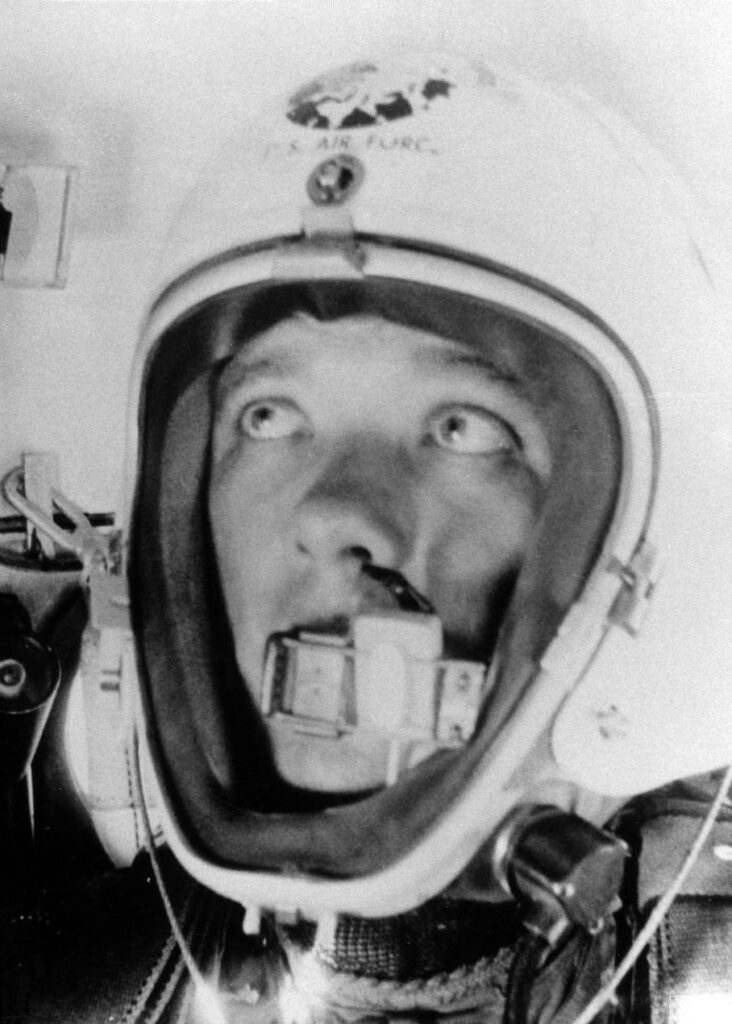David G. Simons was born in Lancaster, Pennsylvania on June 7, 1922. His father and two uncles were physicians and shared a practice in Lancaster. David graduated from high school at the Franklin and Marshall Academy in Lancaster in 1939. He received his medical degree at Jefferson Medical College, Philadelphia, Pennsylvania in 1946, and served his internship at Lancaster General Hospital in Lancaster, Pennsylvania in 1947. Simons entered the U.S. Air Force (USAF) later that year and was assigned to the USAF Aeromedical Laboratory at Wright-Patterson Air Force Base (AFB), Ohio.
In 1947, Simons was named Project Officer for Animal Studies in V-2 rocket flights to high altitudes for Wright-Patterson. The next year, he and Project Director Dr. James P. Henry began conducting pioneering Space Biomedical experiments at White Sands Proving Ground (now White Sands Missile Range), New Mexico and until 1949, Simons was Project Officer for Animal Studies in V-2 rocket flights at White Sands for Wright-Patterson, launching monkeys and mice to the edges of outer space. After graduating from the USAF School of Aerospace Medicine at Randolph AFB, Texas in 1950, Simons was Flight Surgeon at Yakota Air Force Base, Japan from 1950 to 1952.
From 1953 to 1959, Major Simons was Chief of Space Biology at the Air Force Missile Development Center at Holloman Air Force Base, New Mexico. During that time, he was Project Officer on Project 7851, “Human Factors of Space Flight.” This program included 60 high altitude balloon flight experiments studying cosmic radiation effects, weightlessness and space equivalent conditions. In 1957, Simons would take part in the Manhigh project, a series of balloon flights to record altitudes to study the effects of a near-space environment on human physiology.
On August 19 and 20, 1957, Dr. Simons piloted a 32-hour balloon flight to a then-record altitude of 101,516 feet during the Manhigh II mission. Just before dawn on August 19, 1957, Major Simons, wearing a pressure suit, sat in an enclosed gondola beneath the Manhigh II balloon as it rose above Crosby, Minnesota. The balloon ascended rapidly and after two hours and eighteen minutes, it reached almost 100,000 feet.
The balloon was expected to drift westward into Montana, but it was slower than anticipated and never got beyond the eastern part of the Dakotas. The flight was also supposed to last just 24 hours but dragged on almost a half day longer, as Simons in his balloon capsule and tracking parties on the ground looked for a suitable opening in the cloud cover through which to descend. In the afternoon of August 20, Dr. Simons was able to begin a steady rate of descent and finally landed near Frederick, South Dakota.
The Manhigh II flight had lasted thirty-two hours and ten minutes, but Simons had actually been forty-four hours in the cramped capsule, including the time spent before launch. The delay in ending the flight had led to several problems in the capsule environment. The effectiveness of chemicals in the air regeneration system began to decline, carbon dioxide was not absorbed fast enough, and at regular intervals, Major Simons had to use a facemask for breathing. With power supply also running low, it was necessary to cut off the capsule cooling system, and the temperature rose to eighty-four degrees, a situation extremely uncomfortable due to the pressure suit. Despite these problems, Major Simons emerged from the ordeal in good shape and the mission was a great success. In words of Colonel John Stapp “Human performance in an environment equivalent to space is now known to be possible.”
David Simons was featured on the cover of Life magazine in 1957 for this world altitude record for a manned balloon flight. In 1957, he was recognized for this achievement with the FAI Gold Air Medal and the De la Vaulx Medal, both from the Fédération Aéronautique Internationale. From 1959 to 1961, Simons was Chief of the Department of Bioastronautics at Brooks AFB, Texas, before being promoted to Chief of the Flight Medicine Branch, Aerospace Medical Sciences Division, at the School of Aerospace Medicine at Brooks in 1962.
After retiring from the Air Force as a lieutenant colonel on June 30, 1965, Dr. Simons continued his medical research. He and Dr. Janet Travell assembled The Trigger Point Manual, the first definitive textbook on the diagnosis and management of myofascial pain written for clinicians. In 2001, he and Dr. Siegfried Mense published Muscle Pain: Understanding Its Nature, Diagnosis, and Treatment. Dr. David Simons authored almost 200 publications about trigger points and chronic pain management and was recognized internationally for his authoritative research in this field.
Dr. Simons ended his career as a clinical professor in the Rehabilitation Medicine department at Emory University and an adjunct professor at the University of St. Augustine for Health Sciences. He died of heart failure at his home in Covington, Georgia, on April 5, 2010.

